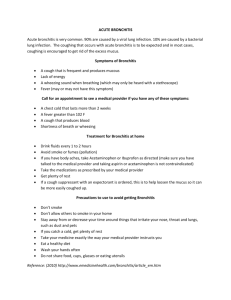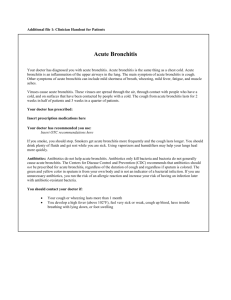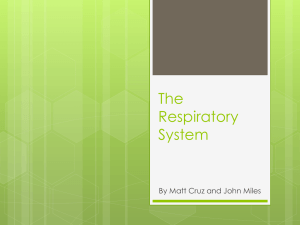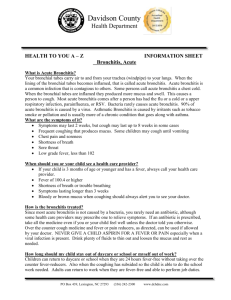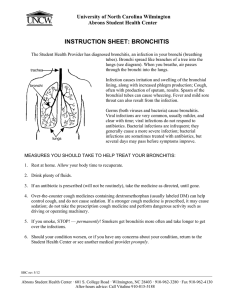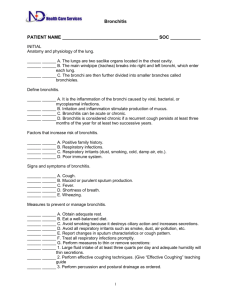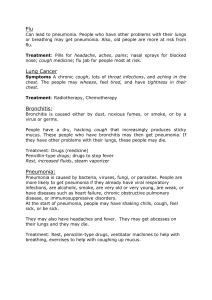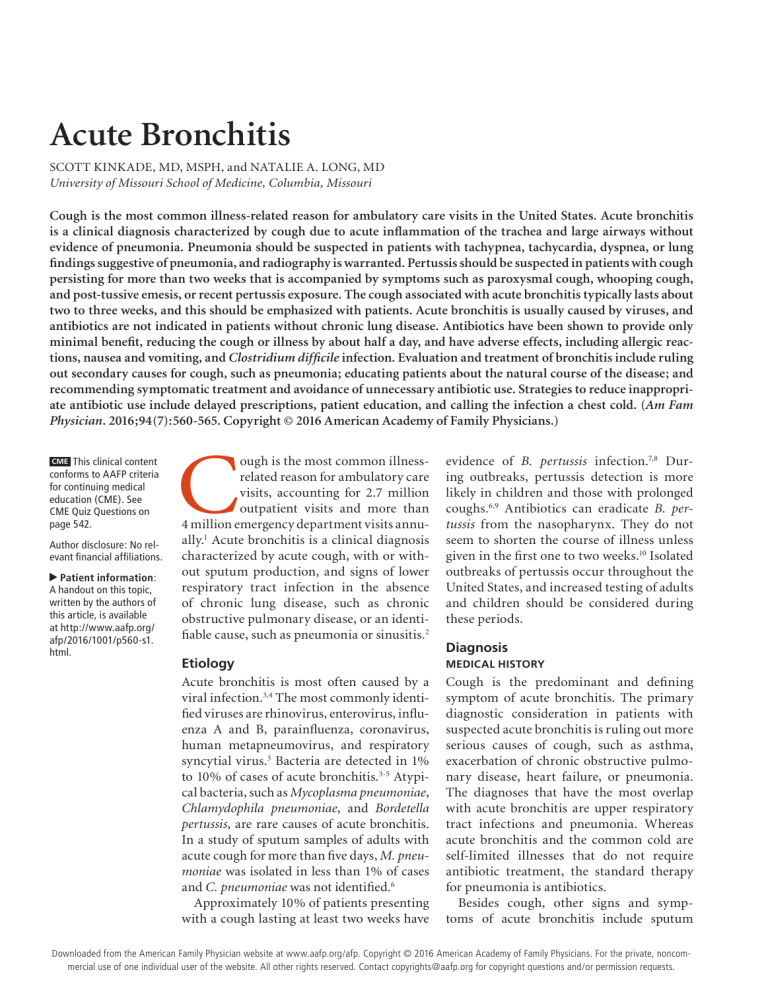
Acute Bronchitis
SCOTT KINKADE, MD, MSPH, and NATALIE A. LONG, MD
University of Missouri School of Medicine, Columbia, Missouri
Cough is the most common illness-related reason for ambulatory care visits in the United States. Acute bronchitis
is a clinical diagnosis characterized by cough due to acute inflammation of the trachea and large airways without
evidence of pneumonia. Pneumonia should be suspected in patients with tachypnea, tachycardia, dyspnea, or lung
findings suggestive of pneumonia, and radiography is warranted. Pertussis should be suspected in patients with cough
persisting for more than two weeks that is accompanied by symptoms such as paroxysmal cough, whooping cough,
and post-tussive emesis, or recent pertussis exposure. The cough associated with acute bronchitis typically lasts about
two to three weeks, and this should be emphasized with patients. Acute bronchitis is usually caused by viruses, and
antibiotics are not indicated in patients without chronic lung disease. Antibiotics have been shown to provide only
minimal benefit, reducing the cough or illness by about half a day, and have adverse effects, including allergic reactions, nausea and vomiting, and Clostridium difficile infection. Evaluation and treatment of bronchitis include ruling
out secondary causes for cough, such as pneumonia; educating patients about the natural course of the disease; and
recommending symptomatic treatment and avoidance of unnecessary antibiotic use. Strategies to reduce inappropriate antibiotic use include delayed prescriptions, patient education, and calling the infection a chest cold. (Am Fam
Physician. 2016;94(7):560-565. Copyright © 2016 American Academy of Family Physicians.)
CME This clinical content
conforms to AAFP criteria
for continuing medical
education (CME). See
CME Quiz Questions on
page 542.
Author disclosure: No relevant financial affiliations.
▲
Patient information:
A handout on this topic,
written by the authors of
this article, is available
at http://www.aafp.org/
afp/2016/1001/p560-s1.
html.
C
ough is the most common illnessrelated reason for ambulatory care
visits, accounting for 2.7 million
outpatient visits and more than
4 million emergency department visits annually.1 Acute bronchitis is a clinical diagnosis
characterized by acute cough, with or without sputum production, and signs of lower
respiratory tract infection in the absence
of chronic lung disease, such as chronic
obstructive pulmonary disease, or an identifiable cause, such as pneumonia or sinusitis.2
evidence of B. pertussis infection.7,8 During outbreaks, pertussis detection is more
likely in children and those with prolonged
coughs.6,9 Antibiotics can eradicate B. pertussis from the nasopharynx. They do not
seem to shorten the course of illness unless
given in the first one to two weeks.10 Isolated
outbreaks of pertussis occur throughout the
United States, and increased testing of adults
and children should be considered during
these periods.
Etiology
Acute bronchitis is most often caused by a
viral infection.3,4 The most commonly identified viruses are rhinovirus, enterovirus, influenza A and B, parainfluenza, coronavirus,
human metapneumovirus, and respiratory
syncytial virus.3 Bacteria are detected in 1%
to 10% of cases of acute bronchitis.3-5 Atypical bacteria, such as Mycoplasma pneumoniae,
Chlamydophila pneumoniae, and Bordetella
pertussis, are rare causes of acute bronchitis.
In a study of sputum samples of adults with
acute cough for more than five days, M. pneumoniae was isolated in less than 1% of cases
and C. pneumoniae was not identified.6
Approximately 10% of patients presenting
with a cough lasting at least two weeks have
MEDICAL HISTORY
Diagnosis
Cough is the predominant and defining
symptom of acute bronchitis. The primary
diagnostic consideration in patients with
suspected acute bronchitis is ruling out more
serious causes of cough, such as asthma,
exacerbation of chronic obstructive pulmonary disease, heart failure, or pneumonia.
The diagnoses that have the most overlap
with acute bronchitis are upper respiratory
tract infections and pneumonia. Whereas
acute bronchitis and the common cold are
self-limited illnesses that do not require
antibiotic treatment, the standard therapy
for pneumonia is antibiotics.
Besides cough, other signs and symptoms of acute bronchitis include sputum
560
American
Family
Physician
www.aafp.org/afp
NumberFor7 theOctober
1, 2016
Downloaded
from the
American
Family Physician website at www.aafp.org/afp.
Copyright © 2016 American AcademyVolume
of Family94,
Physicians.
private, noncom◆
mercial use of one individual user of the website. All other rights reserved. Contact copyrights@aafp.org for copyright questions and/or permission requests.
Acute Bronchitis
SORT: KEY RECOMMENDATIONS FOR PRACTICE
Clinical recommendation
Avoid prescribing antibiotics for uncomplicated acute bronchitis.
Over-the-counter cough medications containing antihistamines and antitussives should not be
used in children younger than four years because of the high potential for harm.
Consider using dextromethorphan, guaifenesin, or honey to manage acute bronchitis symptoms.
Avoid using beta2 agonists for the routine treatment of acute bronchitis unless wheezing is
present.
Employ strategies to reduce antibiotic use, such as asking patients to call for or pick up an
antibiotic or to hold an antibiotic prescription for a set amount of time.
Evidence
rating
References
A
C
27, 41
30
B
B
30, 34, 38
35
A
42, 43
A = consistent, good-quality patient-oriented evidence; B = inconsistent or limited-quality patient-oriented evidence; C = consensus, disease-oriented
evidence, usual practice, expert opinion, or case series. For information about the SORT evidence rating system, go to http://www.aafp.org/afpsort.
production, dyspnea, nasal congestion, headache, and
fever.4,11,12 The first few days of an acute bronchitis infection may be indistinguishable from the common cold.
Patients may have substernal or chest wall pain when
coughing. Fever is not a typical finding after the first few
days, and presence of a fever greater than 100°F (37.8°C)
should prompt consideration of influenza or pneumonia. Production of sputum, even purulent, is common
and does not correlate with bacterial infection.13,14
Because the cough associated with bronchitis is so
bothersome and slow to resolve, patients often seek
treatment. Patients and clinicians may underestimate
the time required to fully recover from acute bronchitis.15 The duration of acute bronchitis–related cough is
typically two to three weeks, with a pooled estimate of
18 days in one systematic review.15 This corresponds to
results of a prospective trial, which found that patients
who had a cough for at least five days had a median of
18 days of coughing.16
PHYSICAL EXAMINATION
On physical examination, patients with acute bronchitis may be mildly ill-appearing, and fever is present in
about one-third of patients.4,11 Lung auscultation may
reveal wheezes, as well as rhonchi that typically improve
with coughing. It is important to rule out pneumonia.
High fever; moderate to severe ill-appearance; hypoxia;
and signs of lung consolidation, such as decreased breath
sounds, bronchial breath sounds, crackles, egophony,
and increased tactile fremitus, are concerning for pneumonia. Pneumonia is unlikely in nonfrail older adults
who have normal vital signs and normal lung examination findings.17-20
BEST PRACTICES IN INFECTIOUS DISEASE:
RECOMMENDATIONS FROM THE CHOOSING WISELY CAMPAIGN
Recommendation
Sponsoring organization
Cough and cold medicines should not be
prescribed or recommended for respiratory
illnesses in children younger than four years.
Antibiotics should not be used for apparent
viral upper respiratory tract illnesses (sinusitis,
pharyngitis, bronchitis).
Avoid prescribing antibiotics for upper
respiratory tract infections.
American Academy of
Pediatrics
American Academy of
Pediatrics
Infectious Diseases
Society of America
Source: For more information on the Choosing Wisely Campaign, see http://www.
choosingwisely.org. For supporting citations and to search Choosing Wisely recommendations relevant to primary care, see http://www.aafp.org/afp/recommendations/
search.htm.
October 1, 2016
◆
Volume 94, Number 7
www.aafp.org/afp
DIAGNOSTIC TESTING
Laboratory testing is usually not indicated
in the evaluation of acute bronchitis. Leukocytosis is present in about 20% of patients;
significant leukocytosis is more likely with
a bacterial infection than with bronchitis.21 Although rapid testing is available for
some respiratory pathogens, it is usually not
necessary in the typical ambulatory care
patient.22 Testing for influenza and pertussis may be considered when the suspicion is
high and treatment would impact the course
of the illness.
Biomarkers may assist in identifying
patients who might benefit from antibiotics. Studies using C-reactive protein levels to
American Family Physician 561
Acute Bronchitis
guide antibiotic use in patients with respiratory tract
infections are inconclusive,23 although an elevated
C-reactive protein level was associated with an increased
likelihood of pneumonia in a large primary care trial.24 A
clinical decision rule for pneumonia was developed and
prospectively validated by Swiss researchers, who found
that pneumonia could be ruled out in patients with a
C-reactive protein level of less than 50 mcg per mL and
no dyspnea or daily fever.25 Procalcitonin testing may
be useful in the differentiation of pneumonia and acute
bronchitis, but it is not widely available in clinical settings.26 A large primary care trial of patients with lower
respiratory tract infections found that procalcitonin
testing added no benefit to a model that included signs,
symptoms, and C-reactive protein levels.24
INDICATIONS FOR CHEST RADIOGRAPHY
In patients with symptoms of acute bronchitis, imaging is primarily used to rule out pneumonia. Evidencebased guidelines from the American College of Chest
Physicians state that imaging is not needed in patients
with acute bronchitis symptoms who have normal vital
signs and normal lung examination findings.22 Patients
with pneumonia typically have tachypnea, tachycardia,
or dyspnea.12 An exception to this rule is patients older
than 75 years, who may present with more subtle signs of
pneumonia and are less likely to have fever or tachycardia.19 Table 1 includes indications for chest radiography
in patients with symptoms of acute bronchitis.22
Management
Supportive care and symptom management are the
mainstay of treatment for acute bronchitis. The role of
antibiotics is limited. Since 2005, the National Committee for Quality Assurance has recommended avoidance
of antibiotic prescribing for acute bronchitis as a Healthcare Effectiveness Data and Information Set Measure.27
Table 1. Indications for Chest Radiography
in Adult Patients with Symptoms of Acute
Bronchitis
Dyspnea, bloody sputum, or rusty sputum color
Pulse > 100 beats per minute
Respiratory rate > 24 breaths per minute
Oral body temperature > 100°F (37.8°C)
Focal consolidation, egophony, or fremitus on chest
examination
Information from reference 22.
562 American Family Physician
All major guidelines on bronchitis, including those from
the American College of Chest Physicians, recommend
against using antibiotics for acute bronchitis unless the
patient has a known pertussis infection.2,22 The American
Academy of Pediatrics recommends that antibiotics not
be used for apparent viral respiratory illnesses, including sinusitis, pharyngitis, and bronchitis.28 Despite these
recommendations, antibiotics are often prescribed for
acute bronchitis.29
OVER-THE-COUNTER MEDICATIONS
Over-the-counter medications are often recommended
as first-line treatment for acute cough. However, a
Cochrane review on over-the-counter medications for
acute cough in the community setting showed a paucity
of good data; existing trials are of low quality and report
conflicting results.30
A randomized controlled trial showed that compared
with placebo, there was no benefit from ibuprofen in
decreasing severity or duration of cough in patients with
acute bronchitis.31 Another randomized controlled trial
comparing ibuprofen, acetaminophen, and steam inhalation found that those with a lower respiratory tract
infection or age younger than 16 years had a modest
reduction in symptom severity when taking ibuprofen
over acetaminophen, although the ibuprofen group was
more likely to seek care again for new or nonresolving
symptoms.32
Antihistamines are often used in combination with
decongestants in the treatment of acute cough. Two trials of antihistamines alone showed no benefit compared
with placebo in relieving cough symptoms. Combination decongestant/antihistamines are more likely to
have adverse effects with no to modest improvement in
cough symptom scores.30 In 2008, The U.S. Food and
Drug Administration warned against the use of overthe-counter cough medications containing antihistamines and antitussives in young children because of the
high risk for harm, and these medications are no longer
labeled for use in children younger than four years. They
are continuing to investigate the safety of these medications in children up to 11 years of age.30,33
ANTITUSSIVES
Antitussives work by reducing the cough reflex and can
be divided into central opioids and peripherally acting
agents. Codeine is a centrally acting, weak opioid that suppresses cough. Two studies show no benefit from codeine
in decreasing cough symptoms,30 and the American College of Chest Physicians does not recommend its use in the
treatment of upper respiratory tract infections.22
www.aafp.org/afp
Volume 94, Number 7
◆
October 1, 2016
Acute Bronchitis
Dextromethorphan is a nonopioid, synthetic derivative of morphine that works centrally to decrease cough.
Three placebo-controlled trials show that dextromethorphan, 30 mg, decreased the cough count by 19% to
36% (P < .05) compared with placebo, which is equivalent to eight to 10 fewer coughing bouts per 30 minutes.30
Benzonatate is a peripherally acting antitussive that is
thought to suppress cough via anesthesia of the respiratory stretch receptors. One small study comparing benzonatate, guaifenesin, and placebo showed significant
improvement with the combination of benzonatate and
guaifenesin, but not with either agent alone.34
EXPECTORANTS
Guaifenesin is a commonly used expectorant. It is
thought to stimulate respiratory tract secretions, thereby
increasing respiratory fluid volumes and decreasing mucus viscosity, and it may also have antitussive
properties.
A Cochrane review including three trials of guaifenesin vs. placebo showed some benefit.30 In one trial,
patients reported that guaifenesin decreased cough frequency and intensity by 75% at 72 hours compared with
31% in the placebo group (number needed to treat = 2).
A second trial showed decreased cough frequency (100%
of the guaifenesin group vs. 94% of the placebo group;
P = .5) and improved cough severity (100% of the guaifenesin group vs. 91% of the placebo group; P = .2) at 36
hours, and reduced sputum thickness (96% of the guaifenesin group vs. 54% of the placebo group; P = .001).
A third trial using an extended-release formulation of
guaifenesin showed improved symptom severity at day 4
but no difference at day 7.30
BETA 2 AGONISTS
Many patients with acute bronchitis have bronchial
hyperreactivity, leading to impaired airflow in a mechanism similar to asthma. A 2015 Cochrane review does not
support the routine use of beta2 agonists for acute cough.35
Two trials included children and found no benefit from
albuterol in decreasing daily cough scores, daily proportion of cough, or median duration of cough, although
both studies excluded children who were wheezing at
the time of evaluation or had signs of bronchial obstruction. The studies of adults had mixed results, but the
findings suggest that beta2 agonists should be avoided
if there is no underlying history of lung disease or evidence of wheeze or airway obstruction. However, beta2
agonists may have some benefit in certain adults, especially those with wheezing at the time of evaluation who
do not have a previous diagnosis of asthma or chronic
October 1, 2016
◆
Volume 94, Number 7
obstructive pulmonary disease. Because there is limited supportive evidence, the use of such medications
should be weighed against the risk of adverse effects,
including tremor, shakiness, and nervousness.35
HERBAL AND OTHER PREPARATIONS
Alternative medications are commonly used in the treatment of acute bronchitis. Pelargonium sidoides has some
reported modest effectiveness in the treatment of acute
bronchitis, but the quality of evidence is considered
low, and the studies were all done by the manufacturer
in Ukraine and Russia.36 There are insufficient data to
recommend for or against the use of Chinese medicinal
herbs for the treatment of acute bronchitis, and there are
safety concerns.37
A Cochrane review of honey for acute cough in children included two small trials comparing honey with
dextromethorphan, diphenhydramine (Benadryl), and
no treatment.38 Honey was found to be better than no
treatment in decreasing the frequency and severity of
cough, decreasing bothersome cough, and improving
quality of sleep. Given the warnings against the use of
antitussives in young children, honey is a reasonable
alternative for the relief of acute cough in children older
than one year.38
ANTIBIOTICS
At least 90% of acute bronchitis episodes are viral, yet
antibiotics are commonly prescribed. Unnecessary
antibiotic prescriptions result in adverse effects and
contribute to rising health care costs and antimicrobial resistance. A recent study of antibiotic prescribing
trends from 1996 to 2010 found that antibiotics were prescribed in 71% of visits for acute bronchitis and that the
rate of prescribing increased during the study period.29
Although clinicians are more likely to prescribe antibiotics in patients with purulent sputum, a prospective observational study showed no difference in outcomes when
antibiotics were prescribed to patients with green or yellow sputum, indicating that this is not a useful indicator
of bacterial infection.39 Smokers are also more likely to
receive antibiotic prescriptions, with some populations
of smokers being prescribed antibiotics more than 90%
of the time despite no difference in outcomes.40
A Cochrane review suggests there is no net benefit
to using antibiotics for acute bronchitis in otherwise
healthy individuals.41 Although antibiotics decreased
cough duration by 0.46 days, decreased ill days by 0.64
days, and decreased limited activity by 0.49 days, there
was no difference in clinical improvement at follow-up.
The most common adverse effects reported were nausea,
www.aafp.org/afp
American Family Physician 563
Acute Bronchitis
Table 2. Strategies to Reduce Antibiotic Use
for Acute Bronchitis
Use delayed prescription strategies, such as asking patients
to call for or pick up an antibiotic or to hold an antibiotic
prescription for a set amount of time
Address patient concerns in a compassionate manner
Discuss the expected course of illness and cough duration
(two to three weeks)
Explain that antibiotics do not significantly shorten illness
duration and are associated with adverse effects and
antibiotic resistance
Discuss the treatment plan, including the use of
nonantibiotic medications to control symptoms
Describe the infection as a viral illness or chest cold
Data Sources: The PubMed database was searched in Clinical Queries
using the term acute bronchitis. Systematic reviews were searched
and narrowed by etiology, diagnosis, therapy, prognosis, and clinical
prediction guidelines. The Agency for Healthcare Research and Quality,
National Guideline Clearinghouse, National Quality Measures Clearinghouse, and Essential Evidence Plus were also searched. Search date:
January 2015.
This review updates a previous article on this topic by Albert,46
Knutson and Braun,47 and Hueston and Mainous.48
NOTE:
The Authors
Information from references 29, 42, and 43.
diarrhea, headache, skin rash, and vaginitis with a
number needed to harm of 5. Given minimal symptom
improvement in an otherwise self-limited condition,
increased rate of adverse effects, and potential for antibiotic resistance, it is wise to limit the use of antibiotics in the general population; further study in frail older
persons and individuals with multiple comorbidities is
needed.41 If pertussis is confirmed or suspected because
of a persistent cough accompanied by symptoms of
paroxysmal cough, whooping cough, and post-tussive
emesis, or recent pertussis exposure, treatment with a
macrolide is recommended.10
STRATEGIES TO REDUCE INAPPROPRIATE ANTIBIOTIC USE
Delayed prescribing, in which the patient is given an antibiotic prescription at the visit but told not to fill it unless
symptoms continue beyond a predetermined time, significantly decreases antibiotic use.42 A Cochrane review
showed no difference in clinical outcomes between
patients with acute bronchitis who were treated immediately with antibiotics and those with delayed or no
antibiotic treatment. In addition, patients reported comparable satisfaction when given immediate vs. delayed
antibiotics (92% vs. 87%).43
Patients who present with the expectation that they
will receive an antibiotic are more likely to receive one,
even if the clinician thinks the prescription is unnecessary.44 In fact, the strongest predictor for an antibiotic
prescription is the clinician’s perception of patient desire
for antibiotics.45 However, patients want symptom relief
and will often accept leaving without an antibiotic prescription if the clinician addresses their concerns, shows
564 American Family Physician
personal interest, discusses the expected course of the
illness, and explains the treatment plan.45 Calling the
infection a chest cold44 and educating the patient about
the expected duration of illness (two to three weeks)15
are also helpful. Table 2 includes strategies for reducing
antibiotic prescriptions for acute bronchitis.29,42,43
SCOTT KINKADE, MD, MSPH, is an associate professor in the Department
of Family and Community Medicine at the University of Missouri School of
Medicine in Columbia.
NATALIE A. LONG, MD, is an assistant professor in the Department of
Family and Community Medicine at the University of Missouri School of
Medicine.
Address correspondence to Scott Kinkade, MD, MSPH, University of
Missouri, MA303 Medical Sciences Bldg., DC032.00, Columbia, MO
65212 (e-mail: kinkades@health.missouri.edu). Reprints are not available from the authors.
REFERENCES
1. National Hospital Ambulatory Medical Care Survey: 2011 outpatient department summary tables. http://www.cdc.gov/nchs/data/ahcd/nhamcs_
outpatient/2011_opd_web_tables.pdf. Accessed March 28, 2015.
2. Woodhead M, Blasi F, Ewig S, et al.; Joint Taskforce of the European
Respiratory Society and European Society for Clinical Microbiology
and Infectious Diseases. Guidelines for the management of adult
lower respiratory tract infections—full version. Clin Microbiol Infect.
2011;17(suppl 6):E1-E59.
3. Clark TW, Medina MJ, Batham S, Curran MD, Parmar S, Nicholson KG.
Adults hospitalised with acute respiratory illness rarely have detectable
bacteria in the absence of COPD or pneumonia; viral infection predominates in a large prospective UK sample. J Infect. 2014;69(5):507-515.
4. Gencay M, Roth M, Christ-Crain M, Mueller B, Tamm M, Stolz D. Single
and multiple viral infections in lower respiratory tract infection. Respiration. 2010;80(6):560-567.
5. Macfarlane J, Holmes W, Gard P, et al. Prospective study of the incidence, aetiology and outcome of adult lower respiratory tract illness in
the community. Thorax. 2001;56(2):109-114.
6. Wadowsky RM, Castilla EA, Laus S, et al. Evaluation of Chlamydia pneumoniae and Mycoplasma pneumoniae as etiologic agents of persistent
cough in adolescents and adults. J Clin Microbiol. 2002;40(2):637-640.
7. Philipson K, Goodyear-Smith F, Grant CC, Chong A, Turner N, Stewart
J. When is acute persistent cough in school-age children and adults
whooping cough? Br J Gen Pract. 2013;63(613):e573-e579.
8. Riffelmann M, Littmann M, Hülsse C, O’Brien J, Wirsing von König CH. Pertussis [in German]. Dtsch Med Wochenschr. 2006;131(50):2829-2834.
9. Cornia PB, Hersh AL, Lipsky et al. Does this coughing adolescent or
adult patient have pertussis? JAMA. 2010;304(8):890-896.
www.aafp.org/afp
Volume 94, Number 7
◆
October 1, 2016
Acute Bronchitis
10. Altunaiji S, Kukuruzovic R, Curtis N, Massie J. Antibiotics for whooping
cough (pertussis). Cochrane Database Syst Rev. 2007;(3):CD004404.
11. Verheij T, Hermans J, Kaptein A, Mulder J. Acute bronchitis: course
of symptoms and restrictions in patients’ daily activities. Scand J Prim
Health Care. 1995;13(1):8-12.
28. American Academy of Pediatrics. Five things physicians and patients
should question. http://www.choosingwisely.org/wp-content/uploads/
2015/02/AAP-Choosing-Wisely-List.pdf. Accessed September 15, 2015.
29. Barnett ML, Linder JA. Antibiotic prescribing for adults with acute bronchitis in the United States, 1996-2010. JAMA. 2014;311(19):2020-2022.
12. van Vugt SF, Verheij TJ, de Jong PA, et al.; GRACE Project Group. Diagnosing pneumonia in patients with acute cough: clinical judgment compared to chest radiography. Eur Respir J. 2013;42(4):1076-1082.
30. Smith SM, Schroeder K, Fahey T. Over-the-counter (OTC) medications
for acute cough in children and adults in community settings. Cochrane
Database Syst Rev. 2014;(11):CD001831.
13. Altiner A, Wilm S, Däubener W, et al. Sputum colour for diagnosis of
a bacterial infection in patients with acute cough. Scand J Prim Health
Care. 2009;27(2):70-73.
31. Llor C, Moragas A, Bayona C, et al. Efficacy of anti-inflammatory or
antibiotic treatment in patients with non-complicated acute bronchitis and discoloured sputum: randomised placebo controlled trial. BMJ.
2013;347:f5762.
14. Steurer J, Held U, Spaar A, et al. A decision aid to rule out pneumonia and reduce unnecessary prescriptions of antibiotics in primary care
patients with cough and fever. BMC Med. 2011;9:56.
15. Ebell MH, Lundgren J, Youngpairoj S. How long does a cough last?
Comparing patients’ expectations with data from a systematic review
of the literature. Ann Fam Med. 2013;11(1):5-13.
32. Little P, Moore M, Kelly J, et al.; PIPS Investigators. Ibuprofen, para­
cetamol, and steam for patients with respiratory tract infections in primary care. BMJ. 2013;347:f6041.
33. Briars LA. The latest update on over-the-counter cough and cold product
use in children. J Pediatr Pharmacol Ther. 2009;14(3):127-131.
16. Ward JI, Cherry JD, Chang SJ, et al.; APERT Study Group. Efficacy of an
acellular pertussis vaccine among adolescents and adults. N Engl J Med.
2005;353(15):1555-1563.
34. Dicpinigaitis PV, Gayle YE, Solomon G, Gilbert RD. Inhibition of coughreflex sensitivity by benzonatate and guaifenesin in acute viral cough.
Respir Med. 2009;103(6):902-906.
17. Ebell MH. Predicting pneumonia in adults with respiratory illness. Am
Fam Physician. 2007;76(4):560-562.
35. Becker LA, Hom J, Villasis-Keever M, van der Wouden JC. Beta2agonists
for acute cough or a clinical diagnosis of acute bronchitis. Cochrane
Database Syst Rev. 2015;(9):CD001726.
18. Wootton DG, Feldman C. The diagnosis of pneumonia requires a chest
radiograph (x-ray) – yes, no or sometimes? Pneumonia. 2014;5:1-7.
19. Metlay JP, Schulz R, Li YH, et al. Influence of age on symptoms at presentation in patients with community-acquired pneumonia. Arch Intern
Med. 1997;157(13):1453-1459.
20. Evertsen J, Baumgardner DJ, Regnery A, Banerjee I. Diagnosis and management of pneumonia and bronchitis in outpatient primary care practices. Prim Care Respir J. 2010;19(3):237-241.
36. Timmer A, Günther J, Motschall E, Rücker G, Antes G, Kern WV. Pelargonium sidoides extract for treating acute respiratory tract infections.
Cochrane Database Syst Rev. 2013;(10):CD006323.
37. Jiang L, Li K, Wu T. Chinese medicinal herbs for acute bronchitis.
Cochrane Database Syst Rev. 2012;(2):CD004560.
38. Oduwole O, Meremikwu MM, Oyo-Ita A, Udoh EE. Honey for acute
cough in children. Cochrane Database Syst Rev. 2014;(12):CD007094.
21. Holm A, Nexoe J, Bistrup LA, et al. Aetiology and prediction of pneumonia in lower respiratory tract infection in primary care. Br J Gen Pract.
2007;57(540):547-554.
39. Butler CC, Kelly MJ, Hood K, et al. Antibiotic prescribing for discoloured
sputum in acute cough/lower respiratory tract infection. Eur Respir J.
2011;38(1):119-125.
22. Braman SS. Chronic cough due to acute bronchitis: ACCP evidencebased clinical practice guidelines. Chest. 2006;129(1 suppl):95S-103S.
40. Oeffinger KC, Snell LM, Foster BM, Panico KG, Archer RK. Treatment of
acute bronchitis in adults. J Fam Pract. 1998;46(6):469-475.
23. Aabenhus R, Jensen JU, Jørgensen KJ, Hróbjartsson A, Bjerrum L. Biomarkers as point-of-care tests to guide prescription of antibiotics in
patients with acute respiratory infections in primary care. Cochrane
Database Syst Rev. 2014;(11):CD010130.
41. Smith SM, Fahey T, Smucny J, Becker LA. Antibiotics for acute bronchitis. Cochrane Database Syst Rev. 2014;(3):CD000245.
24. van Vugt SF, Broekhuizen BD, Lammens C, et al.; GRACE Consortium.
Use of serum C reactive protein and procalcitonin concentrations
in addition to symptoms and signs to predict pneumonia in patients
presenting to primary care with acute cough: diagnostic study. BMJ.
2013;346:f2450.
43. Spurling GK, Del Mar CB, Dooley L, et al. Delayed antibiotics for respiratory infections. Cochrane Database Syst Rev. 2013; (4):CD004417.
25. Held U, Steurer-Stey C, Huber F, Dallafior S, Steurer J. Diagnostic aid to
rule out pneumonia in adults with cough and feeling of fever. A validation study in the primary care setting. BMC Infect Dis. 2012;12:355.
26. Albrich WC, Dusemund F, Bucher B, et al.; ProREAL Study Team. Effectiveness and safety of procalcitonin-guided antibiotic therapy in lower
respiratory tract infections in “real life”: an international, multicenter
poststudy survey (ProREAL) [published correction appears in Arch Intern
Med. 2014;174(6):1011]. Arch Intern Med. 2012;172(9):715-722.
27. National Committee for Quality Assurance. 2015 Healthcare Effectiveness Data and Information Set Measures. http://www.ncqa.org/
Portals/0/HEDISQM/Hedis2015/List_of_HEDIS_2015_Measures.pdf.
Accessed March 10, 2015.
October 1, 2016
◆
Volume 94, Number 7
42. Little P, Moore M, Kelly J, et al. Delayed antibiotic prescribing strategies
for respiratory tract infections in primary care. BMJ. 2014;348:g1606.
44. Phillips TG, Hickner J. Calling acute bronchitis a chest cold may improve
patient satisfaction with appropriate antibiotic use. J Am Board Fam
Pract. 2005;18(6):459-463.
45. Hirschmann JV. Antibiotics for common respiratory tract infections in
adults. Arch Intern Med. 2002;162(3):256-264.
46. Albert RH. Diagnosis and treatment of acute bronchitis. Am Fam Physician. 2010; 82(11):1345-1350.
47. Knutson D, Braun C. Diagnosis and management of acute bronchitis.
Am Fam Physician. 2002;65(10):2039-2044.
48. Hueston WJ, Mainous AG 3rd. Acute bronchitis. Am Fam Physician.
1998;57(6):1270-1276.
www.aafp.org/afp
American Family Physician 565

